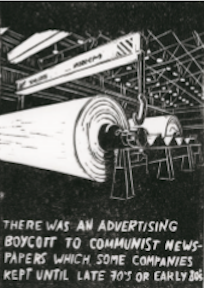Source: Art Review, Oct. 2018
Mike Watson
PRESS TEXT:
Suomi Finland 101
Vantaa Art Museum, 30 August — 13 January
Featuring 17 artists across four rooms, Suomi Finland 101 brings together two-dimensional works, videos and installations that enquire into key social and political issues and underlying power structures in the Nordic nation, which turned 100 last year. These include historical collusion between the media and ruling elite to keep the left from power, an exponential growth in immigration to the country and debate over gender and sexual rights.
Until recently the principal source of income in heavily forested Finland was the paper industry (it’s now metals). As with any largescale industry, its political history is chequered – as Minna Henriksson conveys in Works on Paper (2015-17), 40 linocut prints displayed in a long line. One print, featuring a large paper roll situated in a print warehouse, includes a text that reads, ‘There was an advertising boycott to communist newspapers which some companies kept until late 70s or early 80s’. Other images tell of the Transport Workers Union strikes, leading to the end of open trade with apartheid-era South Africa in the mid-80s. The piece serves to remind us that while Finland frequently ranks highly on worldwide national living standards indexes, it is not without internal division and questionable foreign policies.

Minna Henriksson, Works on Paper (2015-17)
Suspended from the ceiling of the same room is ABC Flags (2013-14) by Kalle Hamm and Dzamil Kamanger (born, respectively, in Finland and Iran): three red banners each bearing alphabets used to write the Kurdish language in, respectively, Turkey (where a Latin alphabet is used), the former Soviet Union (where an adapted Cyrillic alphabet is employed) and Iran, Iraq and Syria (where a modified Arabic alphabet is utilized). The work refers to the fragility of Kurdish cultural identity, the expression of which is marginalized or prohibited in the aforementioned territories.
In the second of two main rooms, Irania-born Bita Razavi’s video installation How to Do Things with Words: A Legal Performance (2011, in collaboration with Jaakko Karhunen) shows a performance of a registry wedding, carried out in the artist’s studio in the Finnish Academy of Fine Arts. As lighting and props recreate the bare and clinical conditions of Helsinki’s official registry office, the two performers enact a familiar yet awkward ritual. Framed on the wall of the museum, a marriage and official residence certificate point to the pragmatism that, for members of Finnish society not born in the country, often underlies the decision to marry. This personal story contributes to the exhibition’s narrative of diversity at the periphery of the Western world as Finland adjusts to demographic change.